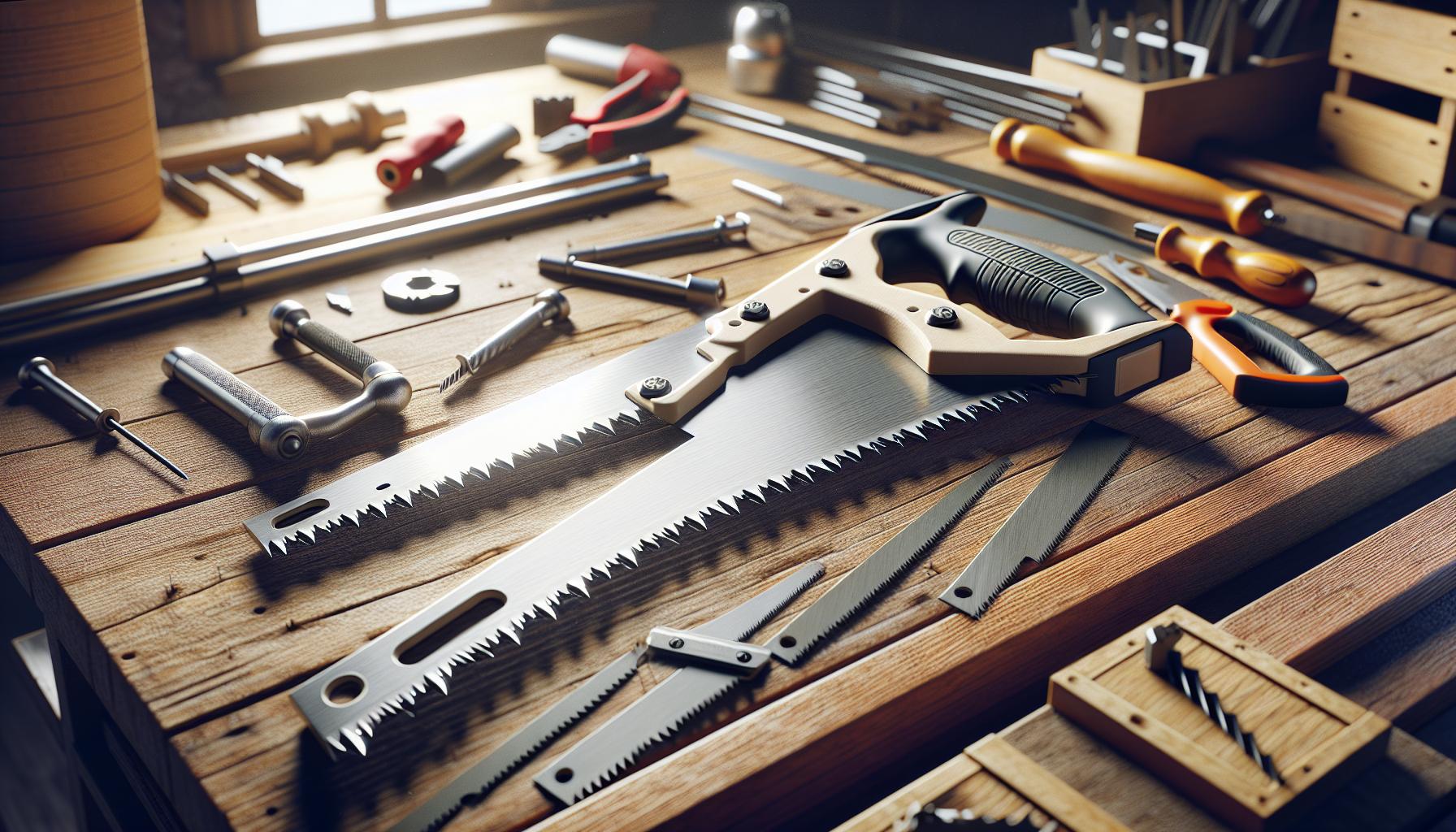When diving into DIY projects, choosing the right saw can make all the difference. Whether you’re crafting furniture or tackling home repairs, the right tool not only enhances your efficiency but also ensures precision. With so many options out there, it can feel overwhelming to pick the best saw for your specific needs.
- Right Saw Choice: Selecting the best saw for DIY projects is crucial for efficiency and precision, depending on the specific tasks you plan to undertake.
- Variety of Saws: Familiarize yourself with different types of saws, such as circular, jigsaw, miter, table, reciprocating, and handsaws, each designed for specific cutting tasks.
- Manual vs. Power Saws: Understand the distinctions between manual saws (like handsaws and coping saws) and power saws (such as circular and miter saws) to choose the best tool for your needs.
- Key Features to Consider: When selecting a saw, pay attention to factors like blade type, safety features, and portability to enhance performance and ensure user safety.
- Safety Practices: Always prioritize safety by wearing personal protective equipment, inspecting tools before use, and maintaining a clean workspace to minimize the risk of accidents.
- Maintenance Tips: Regularly clean, lubricate, and sharpen blades, and store saws properly to extend their lifespan and maintain cutting efficiency.
Best Saw For DIY Projects
Selecting the best saw for DIY projects depends on the specific tasks I plan to accomplish. Various saw types offer distinct advantages based on their design and intended use. Here are some of the top options to consider:
1. Circular Saw
Circular saws deliver versatility and power, making them ideal for straight cuts in wood and sheet materials. They excel in tasks like framing and flooring installation. With a blade diameter of 7 1/4 inches, they handle most cutting depths effectively.
2. Jigsaw
Jigsaws provide precision and control, perfect for intricate cuts and curves. They accommodate various blade types, allowing cuts in materials like wood, metal, and plastic. With a variable speed feature, I can adjust the cutting speed based on the project requirements.
3. Miter Saw
Miter saws excel at making angled cuts, ideal for trim work and complex joinery. They come in compound and sliding options, with blade sizes ranging from 10 to 12 inches. This tool is beneficial for projects requiring crosscuts and bevel cuts.
4. Table Saw
Table saws offer stability and accuracy, making them suited for ripping and cross-cutting large boards. Their stationary design allows for consistent cuts with a guide for aligning materials. With options like portable table saws, they can fit in small workshop spaces.
5. Reciprocating Saw
Reciprocating saws are excellent for demolition work and cutting through rough materials. They handle various cutting tasks efficiently due to their robust design. The flexibility of using different blade types helps tackle wood, metal, and masonry with ease.
6. Handsaw
Handsaws provide a classic, hands-on approach, suitable for smaller tasks or detailed work. They come in multiple designs, including panel saws and back saws. Their lightweight nature makes them easy to handle for quick cuts without the need for electrical power.
Each saw serves unique functions, so assessing project needs ensures I select the most appropriate tool for optimal results. The right saw enhances productivity, making each project more fulfilling and manageable.
Types Of Saws

Saws come in two primary categories: manual and power. Each type offers distinct advantages and is suited for specific tasks, making it essential to understand their functionalities for effective DIY projects.
Manual Saws
Manual saws operate without electricity, relying on physical effort to create cuts. They provide greater control and are often quieter, making them ideal for smaller tasks or delicate work. Common types of manual saws include:
- Handsaw: Commonly used for general wood cutting, the handsaw is lightweight and easy to maneuver. It’s great for straight cuts and requires minimal setup.
- Back Saw: This saw features a reinforced back for stability, often used for precise cuts in joinery and trim work.
- Coping Saw: Ideal for intricate and curved cuts, the coping saw allows for flexibility in tight spaces and can handle various materials.
- Hack Saw: Designed for cutting metal and plastic, the hack saw has fine teeth and typically comes with interchangeable blades.
Power Saws
Power saws operate using electric motors, offering efficiency and speed for larger projects. They’re particularly useful for cutting through dense materials or when precision in repetitive cuts is necessary. Notable types of power saws include:
- Circular Saw: This versatile tool excels at making straight cuts in various materials, including plywood and lumber. It offers adjustability for depth and angle, enhancing flexibility.
- Jigsaw: Known for its ability to execute intricate cuts and curves, the jigsaw features a straight saw blade that moves up and down. It’s suitable for various materials, including wood and metal.
- Miter Saw: Best for making angled cuts, the miter saw provides accuracy for trim work and frame construction. It often includes features like laser guides for enhanced precision.
- Table Saw: This stationary saw is perfect for ripping and cross-cutting large boards. Its flat surface offers stability, allowing for precise measurements and cuts.
- Reciprocating Saw: Ideal for demolition tasks, the reciprocating saw cuts through tough materials quickly. It’s great for rough cuts and renovations.
Understanding these types of saws enhances decision-making based on project needs, paving the way for effective DIY outcomes.
Factors To Consider When Choosing A Saw

Understanding key factors helps in selecting the right saw for DIY projects. The process involves assessing various features tailored to specific needs.
Blade Type
Choosing the right blade type directly impacts cutting performance. Common blade types include:
- Carbide-Tipped Blades: Durable and ideal for cutting hardwood and composite materials.
- High-Speed Steel Blades: Best for general-purpose tasks; these blades wear faster.
- Bi-Metal Blades: Suitable for both metal and wood, offering flexibility and durability.
- Specialty Blades: Designed for specific tasks like plywood or plastics.
Selecting the correct blade ensures efficient performance tailored to the material at hand.
Safety Features
Prioritizing safety features is crucial when selecting a saw. Key safety features include:
- Blade Guard: Protects users from accidental contact with the blade during operation.
- Electric Brake: Stops blade rotation swiftly, reducing potential injury risks.
- Laser Guide: Provides a visual cutting line, improving accuracy and reducing mistakes.
- Ergonomic Handle: Enhances grip and reduces fatigue during prolonged use.
Considering these safety elements enhances user protection during DIY tasks.
Portability
Evaluating portability affects convenience, especially for projects in various locations. Factors to consider include:
- Weight: Lighter saws simplify transport, making them ideal for mobile projects.
- Size: Compact models fit easily in limited workspace or storage areas.
- Corded vs. Cordless: Cordless saws offer freedom of movement, while corded options may provide more power for demanding tasks.
Adopting a portable saw aligns with project flexibility and ease of use.
Top Saws For DIY Projects

Selecting the right saw enhances efficiency and precision in DIY projects. Below are key saw types well-suited for various tasks, ensuring optimal results.
Circular Saws
Circular saws stand out for their versatility and power. They excel at making straight cuts in wood and sheet materials, making them ideal for framing, shelving, and crosscutting. With a variety of blade sizes, typically ranging from 6.5 inches to 8.5 inches, these saws can handle different thicknesses and types of materials. Features like laser guides improve accuracy, while adjustable speed settings offer flexibility for cutting diverse materials like plywood and MDF.
Jigsaws
Jigsaws are perfect for executing intricate cuts and curves. With their narrow blades and variable speed control, they handle detailed tasks such as crafting fine furniture or creating custom designs. Blade options, including T-shank or U-shank, cater to specific types of cuts and material thicknesses. Curve-cutting capabilities enhance artistic possibilities, making jigsaws a popular choice for DIY enthusiasts looking to add detailed elements to their projects.
Reciprocating Saws
Reciprocating saws perform exceptionally well for demolition and cutting through rough materials. Their powerful blades move rapidly back and forth, allowing for quick cuts in wood, metal, and plastic. Blade lengths typically range from 6 inches to 12 inches, enabling the cutting of various materials with ease. These saws are particularly useful for remodeling tasks, tree cutting, and breaking down pallets. With features like variable speed triggers and orbital action, reciprocating saws enhance control and efficiency during tough cuts.
Tips For Using Saws Effectively
Using saws safely and maintaining them properly enhances their performance and longevity. Here are essential tips for effective saw use.
Safety Precautions
- Wear Personal Protective Equipment (PPE): Always wear safety glasses to protect your eyes from debris and gloves to provide a secure grip.
- Inspect Tools Before Use: Check saws for damage, including blades and cords. Replace any worn components immediately.
- Secure Workpieces: Always clamp down materials to prevent movement during cutting, ensuring a stable cutting surface.
- Know the Tool’s Operation: Familiarize yourself with the specific saw’s functions, including start, stop, and safety features, before using it.
- Maintain a Clean Workspace: Keep the area clear of clutter and obstacles to reduce the risk of accidents.
- Switch Off When Not In Use: Always turn off the saw and unplug it when changing blades or adjusting settings.
- Clean Blades Regularly: Remove sawdust and residues from blades to maintain cutting efficiency and extend their life.
- Lubricate Moving Parts: Apply lubricants to hinges and other moving components to ensure smooth operation, following manufacturer guidelines.
- Store Properly: Keep saws in a dry, safe environment when not in use. Use blade guards or cases to protect blades.
- Sharpen Blades as Needed: Regularly review blade sharpness. Dull blades require more effort and can cause accidents.
- Check Electrical Cords: Regularly inspect power cords for frays or breaks. Replace damaged cords immediately to prevent electrical hazards.
- Follow Manufacturer Instructions: Adhere to specific maintenance schedules and guidelines outlined in the operation manual for optimal performance.
Choosing the best saw for DIY projects can truly elevate your craftsmanship. With the right tool in hand you’ll find that tasks become more manageable and enjoyable. Whether you need the versatility of a circular saw or the precision of a jigsaw understanding your specific needs is key.
Investing time in selecting the best saw for DIY projects saw ensures that you’re equipped for success. Don’t forget to prioritize safety features and proper usage techniques to maximize efficiency while keeping yourself protected. With the right saw you’ll be ready to tackle any project that comes your way and achieve results you can be proud of. Happy DIYing!

